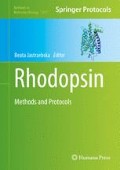Abstract
Conserved structural waters trapped within GPCRs may form water networks indispensable for GPCR’s signaling functions. Radiolysis-based hydroxyl radical footprinting (HRF) strategies coupled to mass spectrometry have been used to explore the structural waters within rhodopsin in multiple signaling states. These approaches, combined with 18O labeling, can be used to identify the locations of structural waters in the transmembrane region and measure rates of water exchange with bulk solvent. Reorganizations of structural waters upon activation of signaling can be explicitly observed with this approach, and this provides a unique look at the structural modules driving the signaling process.
Access this chapter
Tax calculation will be finalised at checkout
Purchases are for personal use only
References
Wang L, Chance MR (2011) Structural mass spectrometry of proteins using hydroxyl radical based protein footprinting. Anal Chem 83:7234–7241
Kiselar JG, Chance MR (2010) Future directions of structural mass spectrometry using hydroxyl radical footprinting. J Mass Spectrom 45:1373–1382
Konermann L, Stocks BB, Pan Y et al (2010) Mass spectrometry combined with oxidative labeling for exploring protein structure and folding. Mass Spectrom Rev 29:651–667
Xu G, Chance MR (2007) Hydroxyl radical-mediated modification of proteins as probes for structural proteomics. Chem Rev 107:3514–3543
Orban T, Jastrzebska B, Gupta S et al (2012) Conformational dynamics of activation for the pentameric complex of dimeric G protein-coupled receptor and heterotrimeric G protein. Structure 20:826–840
Angel TE, Chance MR, Palczewski K (2009) Conserved waters mediate structural and functional activation of family A (rhodopsin-like) G protein-coupled receptors. Proc Natl Acad Sci U S A 106:8555–8560
Angel TE, Gupta S, Jastrzebska B et al (2009) Structural waters define a functional channel mediating activation of the GPCR, rhodopsin. Proc Natl Acad Sci U S A 106:14367–14372
Hoskison TK, Wortmann RL (2006) Advances in the management of gout and hyperuricemia. Scand J Rheumatol 35:251–260
Okada T, Fujiyoshi Y, Silow M et al (2002) Functional role of internal water molecules in rhodopsin revealed by X-ray crystallography. Proc Natl Acad Sci U S A 99:5982–5987
Hofmann KP, Scheerer P, Hildebrand PW et al (2009) A G protein-coupled receptor at work: the rhodopsin model. Trends Biochem Sci 34:540–552
Padayatti PS, Wang L, Gupta S et al (2013) A hybrid structural approach to analyze ligand binding by the serotonin type 4 receptor (5-HT4). Mol Cell Proteomics 12:1259–1271
Orban T, Gupta S, Palczewski K et al (2010) Visualizing water molecules in transmembrane proteins using radiolytic labeling methods. Biochemistry 49:827–834
Gupta S, Sullivan M, Toomey J et al (2007) The beamline X28C of the center for synchrotron biosciences: a national resource for biomolecular structure and dynamics experiments using synchrotron footprinting. J Synchrotron Radiat 14:233–243
Papermaster DS (1982) Preparation of antibodies to rhodopsin and the large protein of rod outer segments. Methods Enzymol 81:240–246
Okada T, Tsujinimoto R, Muraoka M et al (2005) Methods and results in X ray crystallography of bovine rhodopsin, in G protein-couples receptors. In: Haga T (ed) Structure, function, and ligand screening. CRC Press LLC, Boca Raton, FL, pp 245–261
Jastrzebska B, Ringler P, Lodowski DT et al (2011) Rhodopsin-transducin heteropentamer: three-dimensional structure and biochemical characterization. J Struct Biol 176:387–394
Goc A, Angel TE, Jastrzebska B et al (2008) Different properties of the native and reconstituted heterotrimeric G protein transducin. Biochemistry 47:12409–12419
Xu H, Freitas MA (2010) A dynamic noise level algorithm for spectral screening of peptide MS/MS spectra. BMC Bioinformatics 11:436
Sun ZY, Oh KJ, Kim M et al (2008) HIV-1 broadly neutralizing antibody extracts its epitope from a kinked gp41 ectodomain region on the viral membrane. Immunity 28:52–63
Kaur P, Kiselar JG, Chance MR (2009) Integrated algorithms for high-throughput examination of covalently labeled biomolecules by structural mass spectrometry. Anal Chem 81:8141–8149
Gupta S, D'Mello R, Chance MR (2012) Structure and dynamics of protein waters revealed by radiolysis and mass spectrometry. Proc Natl Acad Sci U S A 109:14882–14887
Xu G, Kiselar J, He Q et al (2005) Secondary reactions and strategies to improve quantitative protein footprinting. Anal Chem 77:3029–3037
Wisniewski JR, Zougman A, Nagaraj N et al (2009) Universal sample preparation method for proteome analysis. Nat Methods 6:359–362
Takamoto K, Chance MR (2006) Radiolytic protein footprinting with mass spectrometry to probe the structure of macromolecular complexes. Annu Rev Biophys Biomol Struct 35:251–276
Maleknia SD, Chance MR, Downard KM (1999) Electrospray-assisted modification of proteins: a radical probe of protein structure. Rapid Commun Mass Spectrom 13:2352–2358
Kiselar JG, Mahaffy R, Pollard TD et al (2007) Visualizing Arp2/3 complex activation mediated by binding of ATP and WASp using structural mass spectrometry. Proc Natl Acad Sci U S A 104:1552–1557
Okada T, Sugihara M, Bondar AN et al (2004) The retinal conformation and its environment in rhodopsin in light of a new 2.2 A crystal structure. J Mol Biol 342:571–583
Author information
Authors and Affiliations
Corresponding author
Editor information
Editors and Affiliations
Rights and permissions
Copyright information
© 2015 Springer Science+Business Media New York
About this protocol
Cite this protocol
Wang, L., Chance, M.R. (2015). Detection of Structural Waters and Their Role in Structural Dynamics of Rhodopsin Activation. In: Jastrzebska, B. (eds) Rhodopsin. Methods in Molecular Biology, vol 1271. Humana Press, New York, NY. https://doi.org/10.1007/978-1-4939-2330-4_7
Download citation
DOI: https://doi.org/10.1007/978-1-4939-2330-4_7
Published:
Publisher Name: Humana Press, New York, NY
Print ISBN: 978-1-4939-2329-8
Online ISBN: 978-1-4939-2330-4
eBook Packages: Springer Protocols

